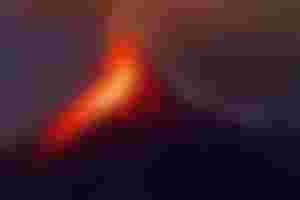The word volcano originated from the Latin word vulcanus - burning mountain, ie from the word Vulcan - god of fire and fire in ancient Rome. Volcanoes consist of a volcanic cone (formed by the accumulation of lava on the surface) and a crater (an opening through which an eruption erupts). Have you ever wondered how and why volcanoes form? Have you ever wondered where a lion comes from?
Although all volcanoes are formed from hot magma that erupts to the Earth's surface and cools and settles there, there are different types of volcanoes. Shield volcanoes generally have milder eruptions of low-viscosity lava, which makes them very wide with slightly sloping sides. Stratovolcanoes are formed from different types of lava that erupt to great heights, followed by ash and rocks. Cone-shaped volcanoes are usually smaller, almost entirely built of erupted lava, and have a large crater. Also, volcanoes can rise like mountains, they can be level with the surface of the Earth, and they can be below the surface level in the oceans. About 30 -50 km below your feet on the Earth's surface stretches the crust (mostly of granite and silicate), beneath which is a layer in a liquid state, where temperatures are high and where there is in fact a storehouse of magma or liquid rock. Magma is lighter than the rocks that surround it, so it rises, finding openings and cracks in the Earth's crust. When it finally reaches the surface, it erupts in the form of an eruption, together with ash, volcanic gases and rocks or stones. Below the surface it is called magma, and when it erupts on the surface of the Earth we call it lava.

An active volcano is one that has erupted relatively recently in a historical period or that is currently active. A dormant volcano is one that erupted long ago, decades or even centuries ago, but has the potential to erupt again. An extinct volcano is one that has not erupted for a very long time and which scientists believe will probably no longer be active. It is not uncommon for scientists to err in their estimation and for the volcano they thought was extinct to reactivate. Although some volcanoes take thousands of years to form, others can form overnight. For example, the cone-shaped volcano Parikutin appeared in a Mexican corn field on February 20, 1943. In just one week, it grew to a height of five floors, and by the end of that year, it had grown to a height of over 336 meters. It finished growing in 1952 at a height of 424 meters, and by geological standards it is very fast.
Geologists estimate that about 1,500 volcanoes have erupted in the last 10,000 years. Three-quarters of eruptions occur at the bottom of the ocean, and geologists do not even know about most of them. One of the reasons why volcanoes appear in the middle of the ocean is the movement of oceanic tectonic plates. If we add underwater volcanoes, it can be estimated that over 6,000 volcanoes have erupted in the last 10,000 years. But you already knew this. Some of the deadliest volcanoes are: 1. Krakatoa - (eruption in 1883) created a tsunami that killed 36,000 people; 2. Vesuvius - (eruption in 79) completely destroyed the cities of Pompeii and Herculaneum and killed 16,000 people; 3. Mont Pele on the island of Martinique (eruption in 1902) destroyed a city of 30,000 people. The most dangerous are pyroclastic flows that trickle down during the eruption and fry everything in front of them. They consist of lava, ash and stones and move incredibly fast (several hundred km / h each) and reach temperatures over 1,000 ° C.
The highest volcano in the solar system is not on Earth. The largest shield volcano is Olympus on Mars. It is about 21 km high and about 540 km wide. Scientists believe that this volcano managed to reach that scale because there are no tectonic plates on Mars. Without any displacements or disturbances, this volcano has been able to operate for millions of years and is getting bigger and bigger. It's off now. The highest and largest volcano on Earth are located next to each other - the highest is Mauna Kea (4,207 m), and the largest is Mauna Loa (4,169 m). Both belong to the Pacific Fire Belt, are located in Hawaii and both are shield volcanoes rising from the ocean floor. If the Mauna Kea volcano were measured from the base on the ocean floor to the top, it would get its true height of 10,203 m, which is higher than Mount Everest.
